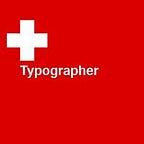About Legibility and Readability
Functional accessibility in typography includes legibility and readability among other things, and often the two terms are applied interchangeably. It is important to have a clear definition of what each does to be able to identify a potential accessibility hurdle. A great variety of factors can of course affect the legibility of a typeface and the readability of a typographic setting. For avoidance of misunderstanding, the below descriptions of legibility and readability are based on neuroscientific definitions and are used for objective testing.
Legibility is the definition of how quickly and accurately a reader can recognise a character in any given writing system, in any given language. This is purely about the shaping of a character and when legibility testing is applied, external factors such as reading conditions and the test participant abilities need to be taken into account. Legibility testing is usually carried out by presenting the participant with a single character starting with a very short duration of a few milliseconds. The duration is increased until the participant can correctly identify a series of characters. The lower the duration with a large count of correct answers, the better the legibility. Legibility is an objective measure and does not depend on emotional factors.
All writing systems contain characters that have likeness with one another and create ambiguity. The degree of ambiguity depends on the actual design of the typeface and the size at which characters are presented: smaller characters may need more effort than larger ones to be correctly identified.
Readability is the definition of how smoothly and quickly a reader can read a passage of text, irrespective of the content of that text. The choice of typeface is important in this context but more important are letter and line spacing. They determine how easily the eyes can fixate during a saccade. Smoothness of reading is dependent on regular and consecutive saccade flow, and is interrupted when the eyes have to jump back and forth on a line of text. Readability has a considerable impact on comprehension and the smoother the reading the higher the comprehension. Readability testing is usually carried out with the participant’s eye movements tracked. The test also measures the duration it takes the participant to read a passage of text and provides objective results.
As with legibility, readability applies to all writing systems but additional factors may contribute to effective readability beyond letter and line spacing. Highly complex systems with conjunctive shape changing, or complex Chinese ideographs, may affect how we have to measure and regard readability. Unfortunately, little to no research has been carried out for writing systems other than Latin.
Word Superiority Effect
The above definitions of legibility and readability apply to all types of reading, whether that is a single letter, a word or a passage of text. Individual letter shapes need to be correctly identified and entire words or sentences need to be smoothly read. A short word may only require a single fixation to capture the letter shapes but smoothness still is likely to apply in that there is no need for a further fixation to ascertain the correct identification of the letter shapes. We also have to consider the Word Superiority Effect (WSE) that allows the brain to allocate meaning to a word based on the broad visual shape of the word itself. The WSE is also responsible for why we sometimes do not ‘see’ a spelling mistake. It is important to note that numbers are read in a different part of the brain than regular letters.
Both legibility and readability can be impacted by surrounding and ambient conditions. A typeface can be highly legible under optimal conditions but can easily deteriorate to illegibility if conditions are suboptimal, or the impact of the display method has not been considered properly. Readability, too, is susceptible to ambient conditions but tends to be affected by poor typographic decision making like tightening the space between characters or between lines.
Good practice in typography
When setting type for good legibility and readability, contrast is one of the main factors that need to be considered, applicable to both typeface style and colour. High contrast typefaces set at reading sizes tend to create a striping effect due to their strong vertical emphasis. This can affect legibility in that ambiguity between characters may be increased. It certainly impacts readability as it is much harder for the eyes to find their fixations due to the striping which in turn creates a stroboscopic effect. It is therefore preferable to choose a lower contrast typeface that leaves a more even tone on the page. Titling and display sizes are less affected by high contrast type.
Colour contrast also needs to be considered and traditional book typography always sets type using off-black ink on off-white paper. Reduced fore-/background contrast is simply good design practice that has been in use in wayfinding and signage for a long time. In those environments, one can often find white type on dark blue, or black on yellow. There is no reason why those principles cannot be applied to text sizes in all typographic layouts.
Digital typography poses many challenges to legibility and readability, and of course to typographic accessibility at large. The creator or designer of a digital typographic layout may have the best intentions at heart but simply cannot control how this layout displays on a recipient’s device. When we design with the intention of good legibility and readability we must make use of the latest technologies but at the same time bear our audience in mind, some of whom may not have access to such latest technologies. Emotional, functional and technical accessibility have to be considered as one to provide the most optimal legibility and readability.
Follow the @ReadabilityGrp for regular insights and discussions about accessibility in typography.
